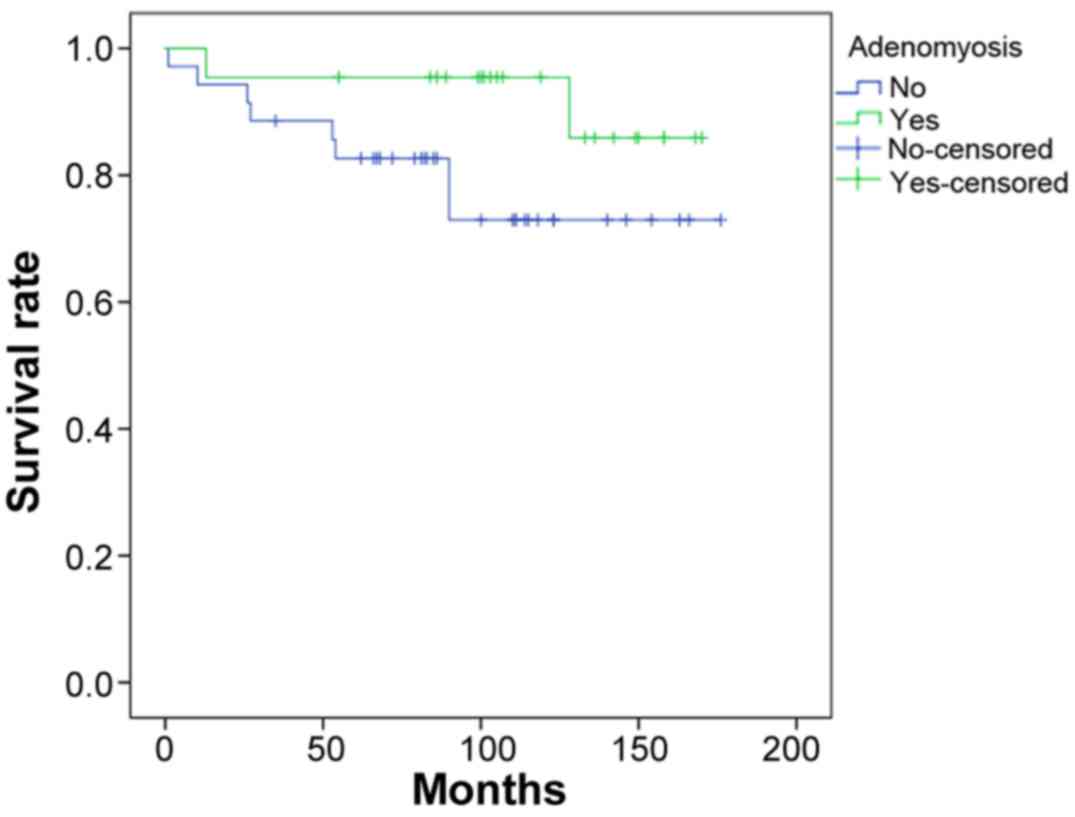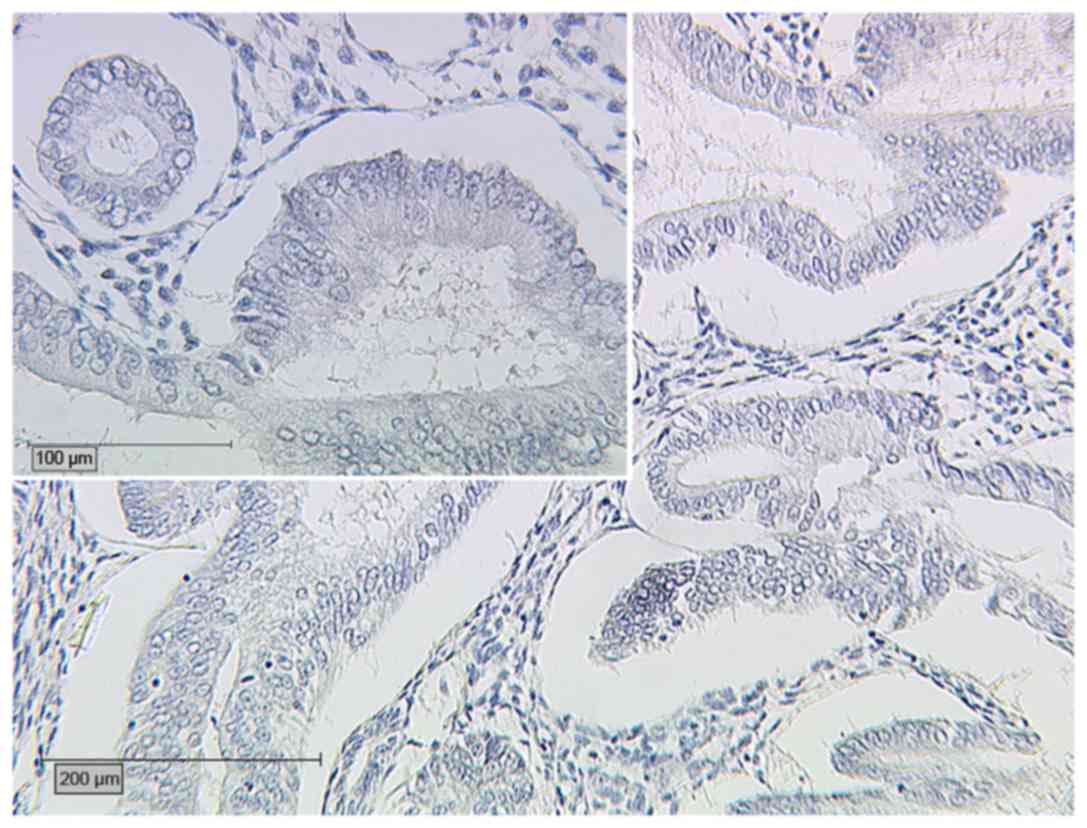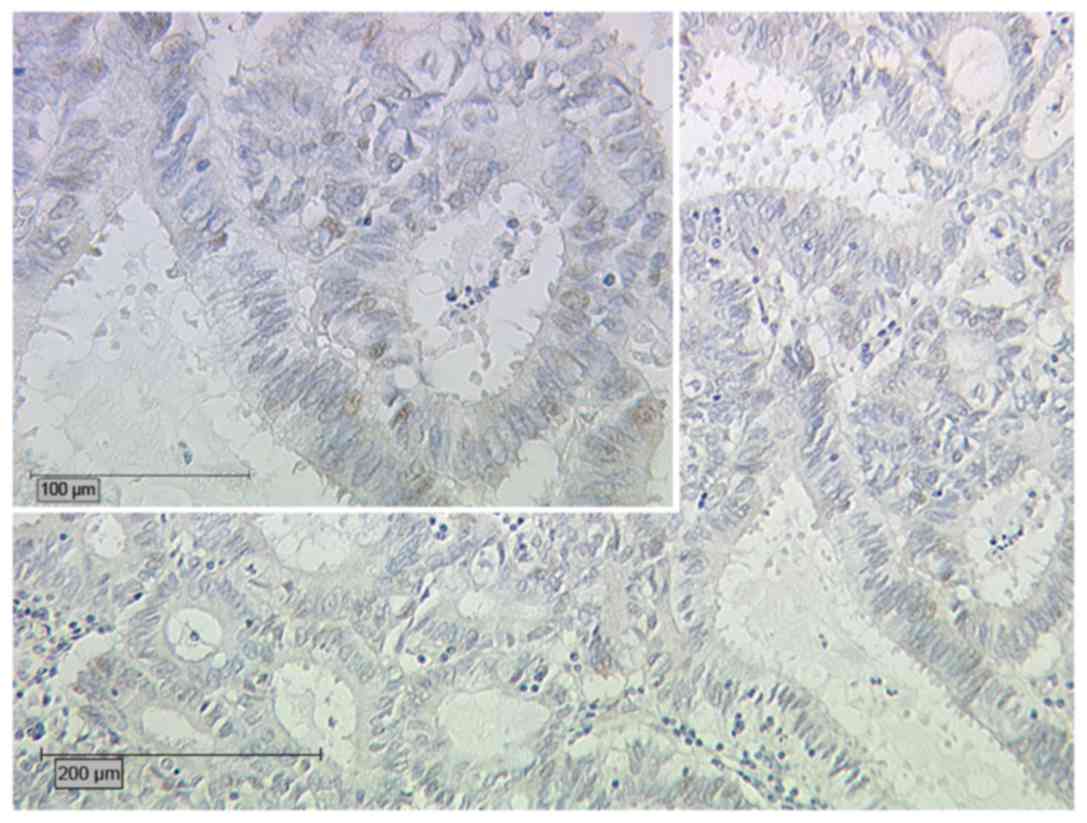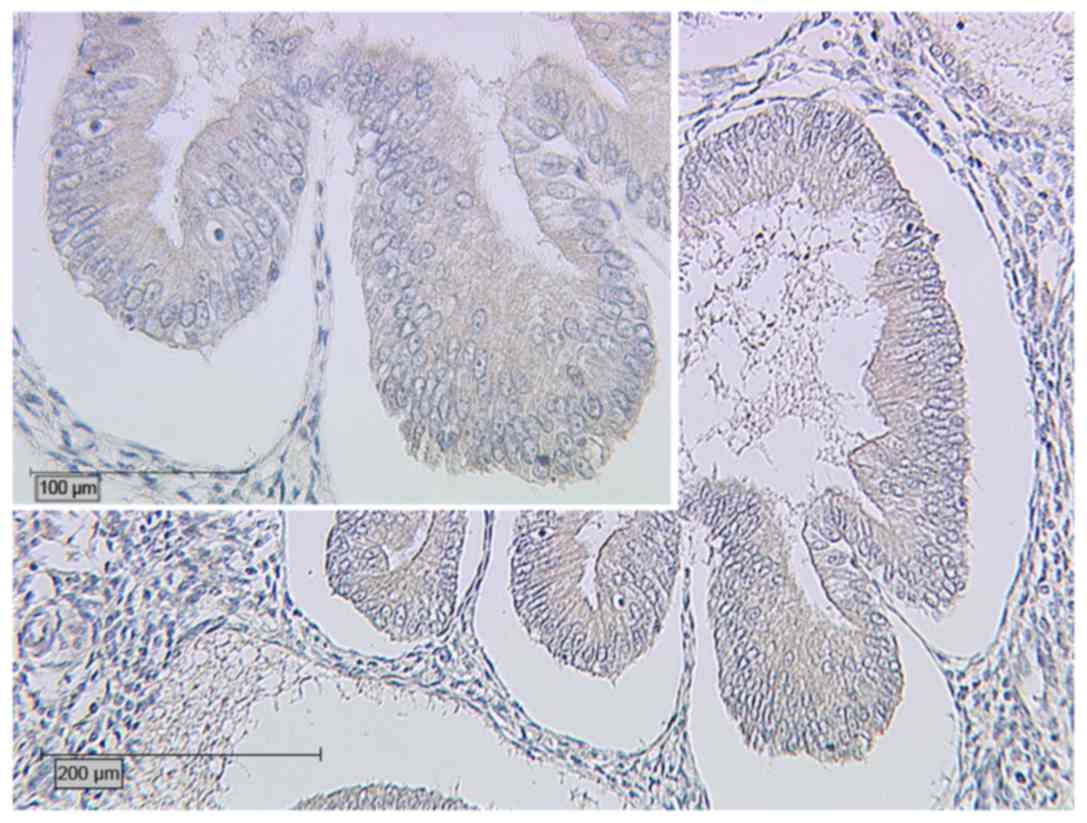|
1
|
Siegel RL, Miller KD and Jemal A: Cancer
statistics, 2016. CA Cancer J Clin. 66:7–30. 2016. View Article : Google Scholar : PubMed/NCBI
|
|
2
|
Prat J: Prognostic parameters of
endometrial carcinoma. Hum Pathol. 35:649–662. 2004. View Article : Google Scholar : PubMed/NCBI
|
|
3
|
Bergeron C, Amant F and Ferenczy A:
Pathology and physiopathology of adenomyosis. Best Pract Res Clin
Obstet Gynaecol. 20:511–521. 2006. View Article : Google Scholar : PubMed/NCBI
|
|
4
|
Kucera E, Hejda V, Dankovcik R, Valha P,
Dudas M and Feyereisl J: Malignant changes in adenomyosis in
patients with endometrioid adenocarcinoma. Eur J Gynaecol Oncol.
32:182–184. 2011.PubMed/NCBI
|
|
5
|
Ismiil N, Rasty G, Ghorab Z, Nofech-Mozes
S, Bernardini M, Ackerman I, Thomas G, Covens A and Khalifa MA:
Adenomyosis involved by endometrial adenocarcinoma is a significant
risk factor for deep myometrial invasion. Ann Diagn Pathol.
11:252–257. 2007. View Article : Google Scholar : PubMed/NCBI
|
|
6
|
Seidman JD and Kjerulff KH: Pathologic
findings from the Maryland Women's Health Study: Practice patterns
in the diagnosis of adenomyosis. Int J Gynecol Pathol. 15:217–221.
1996. View Article : Google Scholar : PubMed/NCBI
|
|
7
|
Gizzo S, Patrelli TS, Dall'Asta A, Gangi
DIS, Giordano G, Migliavacca C, Monica M, Merisio C, Nardelli GB,
Quaranta M, et al: Coexistence of adenomyosis and endometrioid
endometrial cancer: Role in surgical guidance and prognosis
estimation. Oncol Lett. 11:1213–1219. 2016.PubMed/NCBI
|
|
8
|
Koshiyama M, Okamoto T and Ueta M: The
relationship between endometrial carcinoma and coexistent
adenomyosis uteri, endometriosis externa and myoma uteri. Cancer
Detect Prev. 28:94–98. 2004. View Article : Google Scholar : PubMed/NCBI
|
|
9
|
Mylonas I, Jeschke U, Shabani N, Kuhn C,
Kriegel S, Kupka MS and Friese K: Normal and malignant human
endometrium express immunohistochemically estrogen receptor alpha
(ER-alpha), estrogen receptor beta (ER-beta) and progesterone
receptor (PR). Anticancer Res. 25:1679–1686. 2005.PubMed/NCBI
|
|
10
|
Mylonas I, Jeschke U, Shabani N, Kuhn C,
Balle A, Kriegel S, Kupka MS and Friese K: Immunohistochemical
analysis of estrogen receptor alpha, estrogen receptor beta and
progesterone receptor in normal human endometrium. Acta Histochem.
106:245–252. 2004. View Article : Google Scholar : PubMed/NCBI
|
|
11
|
Brandenberger AW, Lebovic DI, Tee MK, Ryan
IP, Tseng JF, Jaffe RB and Taylor RN: Oestrogen receptor (ER)-alpha
and ER-beta isoforms in normal endometrial and
endometriosis-derived stromal cells. Mol Hum Reprod. 5:651–655.
1999. View Article : Google Scholar : PubMed/NCBI
|
|
12
|
Hapangama DK, Kamal AM and Bulmer JN:
Estrogen receptor β: The guardian of the endometrium. Hum Reprod
Update. 21:174–193. 2015. View Article : Google Scholar : PubMed/NCBI
|
|
13
|
Mylonas I, Speer R, Makovitzky J, Richter
DU, Briese V, Jeschke U and Friese K: Immunohistochemical analysis
of steroid receptors and glycodelin A (PP14) in isolated glandular
epithelial cells of normal human endometrium. Histochem Cell Biol.
114:405–411. 2000.PubMed/NCBI
|
|
14
|
Shabani N, Kuhn C, Kunze S, Schulze S,
Mayr D, Dian D, Gingelmaier A, Schindlbeck C, Willgeroth F, Sommer
H, Jeschke U, et al: Prognostic significance of oestrogen receptor
alpha (ERalpha) and beta (ERbeta), progesterone receptor A (PR-A)
and B (PR-B) in endometrial carcinomas. Eur J Cancer. 43:2434–2444.
2007. View Article : Google Scholar : PubMed/NCBI
|
|
15
|
Bulun SE, Monsavais D, Pavone ME, Dyson M,
Xue Q, Attar E, Tokunaga H and Su EJ: Role of estrogen receptor-β
in endometriosis. Semin Reprod Med. 30:39–45. 2012. View Article : Google Scholar : PubMed/NCBI
|
|
16
|
Paul M, Cholewa K, Mazurek U, Witek A and
Wilczok T: Estrogen receptor beta delta 6 (ER beta delta 6) isoform
in human endometrial hyperplasia and adenocarcinoma. Cancer Invest.
22:211–218. 2004. View Article : Google Scholar : PubMed/NCBI
|
|
17
|
Smuc T and Rizner TL: Aberrant
pre-receptor regulation of estrogen and progesterone action in
endometrial cancer. Mol Cell Endocrinol. 301:74–82. 2009.
View Article : Google Scholar : PubMed/NCBI
|
|
18
|
Skrzypczak M, Bieche I, Szymczak S, Tozlu
S, Lewandowski S, Girault I, Radwanska K, Szczylik C, Jakowicki JA,
Lidereau R and Kaczmarek L: Evaluation of mRNA expression of
estrogen receptor beta and its isoforms in human normal and
neoplastic endometrium. Int J Cancer. 110:783–787. 2004. View Article : Google Scholar : PubMed/NCBI
|
|
19
|
Haring J, Schüler S, Lattrich C, Ortmann O
and Treeck O: Role of estrogen receptor β in gynecological cancer.
Gynecol Oncol. 127:673–676. 2012. View Article : Google Scholar : PubMed/NCBI
|
|
20
|
Horn LC, Schierle K, Schmidt D, Ulrich U,
Liebmann A and Wittekind C: Current TNM/FIGO classification for
cervical and endometrial cancer as well as malignant mixed
mullerian tumors. Facts and background. Pathologe. 32:239–243.
2011.(In German). View Article : Google Scholar : PubMed/NCBI
|
|
21
|
Kricka LJ and Wild D: Signal generation
and detection systems (excluding homogeneous assays)The Immunoassay
Handbook. 3rd. Amsterdam: Elsevier Publisher; pp. 2202005
|
|
22
|
Remmele W and Stegner HE: Recommendation
for uniform definition of an immunoreactive score (IRS) for
immunohistochemical estrogen receptor detection (ER-ICA) in breast
cancer tissue. Pathologe. 8:138–140. 1987.(In German). PubMed/NCBI
|
|
23
|
Tabernero JM, Alonso MC, Ojeda B, Fuentes
J, Balart J, Badia J, Climent MA and Delgado E: Endometrial cancer
stages I and II. Analysis of survival and prognostic factors. Eur J
Gynaecol Oncol. 16:18–25. 1995.PubMed/NCBI
|
|
24
|
Reisinger SA, Staros EB and Mohiuddin M:
Survival and failure analysis in stage II endometrial cancer using
the revised 1988 FIGO staging system. Int J Radiat Oncol Biol Phys.
21:1027–1032. 1991. View Article : Google Scholar : PubMed/NCBI
|
|
25
|
Ayhan A, Taskiran C, Celik C and Yuce K:
The long-term survival of women with surgical stage II endometrioid
type endometrial cancer. Gynecol Oncol. 93:9–13. 2004. View Article : Google Scholar : PubMed/NCBI
|
|
26
|
Mahdi H, Hou H, Kowk LL, Moslemi-Kebria M
and Michener C: Type II endometrial cancer in Hispanic women: Tumor
characteristics, treatment and survival compared to non-Hispanic
white women. Gynecol Oncol. 133:512–517. 2014. View Article : Google Scholar : PubMed/NCBI
|
|
27
|
Koshiyama M, Morita Y, Fujii H, Kobashi Y
and Yoshida M: Gynecologic malignancies accompanied by benign
hormone-dependent diseases. Menopause. 8:149–150. 2001. View Article : Google Scholar : PubMed/NCBI
|
|
28
|
Musa F, Frey MK, Im HB, Chekmareva M,
Ellenson LH and Holcomb K: Does the presence of adenomyosis and
lymphovascular space invasion affect lymph node status in patients
with endometrioid adenocarcinoma of the endometrium? Am J Obstet
Gynecol. 207(417): e1–e6. 2012.
|
|
29
|
Matsuo K, Cahoon SS, Gualtieri M, Scannell
CA, Jung CE, Takano T, Paulson RJ, Muderspach LI and Roman LD:
Significance of adenomyosis on tumor progression and survival
outcome of endometrial cancer. Ann Surg Oncol. 21:4246–4255. 2014.
View Article : Google Scholar : PubMed/NCBI
|
|
30
|
Matsuo K, Moeini A, Machida H, Scannell
CA, Casabar JK, Kakuda M, Adachi S, Garcia-Sayre J, Ueda Y and
Roman LD: Tumor characteristics and survival outcome of endometrial
cancer arising in adenomyosis: An exploratory analysis. Ann Surg
Oncol. 23:959–967. 2016. View Article : Google Scholar : PubMed/NCBI
|
|
31
|
Mehasseb MK, Panchal R, Taylor AH, Brown
L, Bell SC and Habiba M: Estrogen and progesterone receptor isoform
distribution through the menstrual cycle in uteri with and without
adenomyosis. Fertil Steril. 95:2228–2235, 2235.e1. 2011. View Article : Google Scholar : PubMed/NCBI
|
|
32
|
Gingelmaier A, Gutsche S, Mylonas I,
Shabani N, Kuhn C, Kunze S, Jeschke U and Friese K: Expression of
HPV, steroid receptors (ERalpha, ERbeta, PR-A and PR-B) and
inhibin/activin subunits (alpha, betaA and betaB) in adenosquamous
endometrial carcinoma. Anticancer Res. 27:2011–2017.
2007.PubMed/NCBI
|
|
33
|
Lenhard M, Heublein S, Kunert-Keil C,
Vrekoussis T, Lomba I, Ditsch N, Mayr D, Friese K and Jeschke U:
Immunosuppressive Glycodelin A is an independent marker for poor
prognosis in endometrial cancer. BMC Cancer. 13:6162013. View Article : Google Scholar : PubMed/NCBI
|
|
34
|
Mylonas I, Makovitzky J, Hoeing A, Richter
DU, Vogl J, Schulze S, Jeschke U, Briese V and Friese K:
Inhibin/activin subunits beta-A (−betaA) and beta-B (−betaB) are
differentially localised in normal, hyperplastic and malignant
human endometrial tissue. Acta Histochem. 108:1–11. 2006.
View Article : Google Scholar : PubMed/NCBI
|
|
35
|
Panoulis K, Christantoni E, Pliatsika P,
Anagnostis P, Goulis DG, Kondi-Pafiti A, Armeni E, Augoulea A,
Triantafyllou N, Creatsa M and Lambrinoudaki I: Expression of
gonadal steroid receptors in the ovaries of post-menopausal women
with malignant or benign endometrial pathology: A pilot study.
Gynecol Endocrinol. 31:613–617. 2015. View Article : Google Scholar : PubMed/NCBI
|
|
36
|
Mazurkiewicz JE, Bank JF and Joshi SG:
Immunocytochemical localization of a progestagen-associated
endometrial protein in the human decidua. J Clin Endocrinol Metab.
52:1006–1068. 1981. View Article : Google Scholar : PubMed/NCBI
|
|
37
|
Kao LC, Germeyer A, Tulac S, Lobo S, Yang
JP, Taylor RN, Osteen K, Lessey BA and Giudice LC: Expression
profiling of endometrium from women with endometriosis reveals
candidate genes for disease-based implantation failure and
infertility. Endocrinology. 144:2870–2881. 2003. View Article : Google Scholar : PubMed/NCBI
|
|
38
|
Song M, Ramaswamy S, Ramachandran S,
Flowers LC, Horowitz IR, Rock JA and Parthasarathy S: Angiogenic
role for glycodelin in tumorigenesis. Proc Natl Acad Sci U S A.
98:9265–9270. 2001. View Article : Google Scholar : PubMed/NCBI
|
|
39
|
Jeschke U, Kuhn C, Mylonas I, Schulze S,
Friese K, Mayr D, Speer R, Briese V, Richter DU, Haase M and
Karsten U: Development and characterization of monoclonal
antibodies for the immunohistochemical detection of glycodelin A in
decidual, endometrial and gynaecological tumour tissues.
Histopathology. 48:394–406. 2006. View Article : Google Scholar : PubMed/NCBI
|
|
40
|
Jeschke U, Bischof A, Speer R, Briese V,
Richter DU, Bergemann C, Mylonas I, Shabani N, Friese K and Karsten
U: Development of monoclonal and polyclonal antibodies and an ELISA
for the determination of glycodelin in human serum, amniotic fluid
and cystic fluid of benign and malignant ovarian tumors. Anticancer
Res. 25:1581–1589. 2005.PubMed/NCBI
|
|
41
|
Jeschke U, Mylonas I, Kunert-Keil C, Stahn
R, Scholz C, Janni W, Kuhn C, Schröder E, Mayr D and Friese K:
Immunohistochemistry, glycosylation and immunosuppression of
glycodelin in human ovarian cancer. Histochem Cell Biol.
131:283–295. 2009. View Article : Google Scholar : PubMed/NCBI
|
|
42
|
Fazleabas AT, Brudney A, Chai D, Langoi D
and Bulun SE: Steroid receptor and aromatase expression in baboon
endometriotic lesions. Fertil Steril. 80:(Suppl 2). 820–827. 2003.
View Article : Google Scholar : PubMed/NCBI
|
|
43
|
Fazleabas AT, Kim JJ, Srinivasan S,
Donnelly KM, Brudney A and Jaffe RC: Implantation in the baboon:
Endometrial responses. Semin Reprod Endocrinol. 17:257–265. 1999.
View Article : Google Scholar : PubMed/NCBI
|
|
44
|
Vale W, Rivier C, Hsueh A, Campen C,
Meunier H, Bicsak T, Vaughan J, Corrigan A, Bardin W, Sawchenko P,
et al: Chemical and biological characterization of the inhibin
family of protein hormones. Recent Prog Horm Res. 44:1–34.
1988.PubMed/NCBI
|
|
45
|
Mylonas I, Jeschke U, Winkler L,
Makovitzky J, Richter DU, Briese V and Friese K:
Immunohistochemical expression of inhibin-alpha in human
endometrium and the in vitro secretion of inhibin, estradiol and
cortisol in cultured human endometrial glandular cells. Arch
Gynecol Obstet. 268:142–150. 2003. View Article : Google Scholar : PubMed/NCBI
|
|
46
|
Mylonas I, Winkler L, Jeschke U, Briese V
and Friese K: Investigations on isolation, purification and
cultivation of human endometrial cells and on the in vitro inhibin
expression in glandular epithelial cells. Zentralbl Gynakol.
125:415–423. 2003.(In German). PubMed/NCBI
|
















